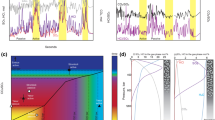Abstract
The rates of passive degassing from volcanoes are investigated by modelling the convective overturn of dense degassed and less dense gas-rich magmas in a vertical conduit linking a shallow degassing zone with a deep magma chamber. Laboratory experiments are used to constrain our theoretical model of the overturn rate and to elaborate on the model of this process presented by Kazahaya et al. (1994). We also introduce the effects of a CO2–saturated deep chamber and adiabatic cooling of ascending magma. We find that overturn occurs by concentric flow of the magmas along the conduit, although the details of the flow depend on the magmas' viscosity ratio. Where convective overturn limits the supply of gas-rich magma, then the gas emission rate is proportional to the flow rate of the overturning magmas (proportional to the density difference driving convection, the conduit radius to the fourth power, and inversely proportional to the degassed magma viscosity) and the mass fraction of water that is degassed. Efficient degassing enhances the density difference but increases the magma viscosity, and this dampens convection. Two degassing volcanoes were modelled. At Stromboli, assuming a 2 km deep, 30% crystalline basaltic chamber, containing 0.5 wt.% dissolved water, the ∼700 kg s–1 magmatic water flux can be modelled with a 4–10 m radius conduit, degassing 20–100% of the available water and all of the 1 to 4 vol.% CO2 chamber gas. At Mount St. Helens in June 1980, assuming a 7 km deep, 39% crystalline dacitic chamber, containing 4.6 wt.% dissolved water, the ∼500 kg s–1 magmatic water flux can be modelled with a 22–60 m radius conduit, degassing ∼2–90% of the available water and all of the 0.1 to 3 vol.% CO2 chamber gas. The range of these results is consistent with previous models and observations. Convection driven by degassing provides a plausible mechanism for transferring volatiles from deep magma chambers to the atmosphere, and it can explain the gas fluxes measured at many persistently active volcanoes.
Similar content being viewed by others
Author information
Authors and Affiliations
Additional information
Received: 26 September 1997 / Accepted: 11 July 1998
Rights and permissions
About this article
Cite this article
Stevenson, D., Blake, S. Modelling the dynamics and thermodynamics of volcanic degassing. Bull Volcanol 60, 307–317 (1998). https://doi.org/10.1007/s004450050234
Issue Date:
DOI: https://doi.org/10.1007/s004450050234




